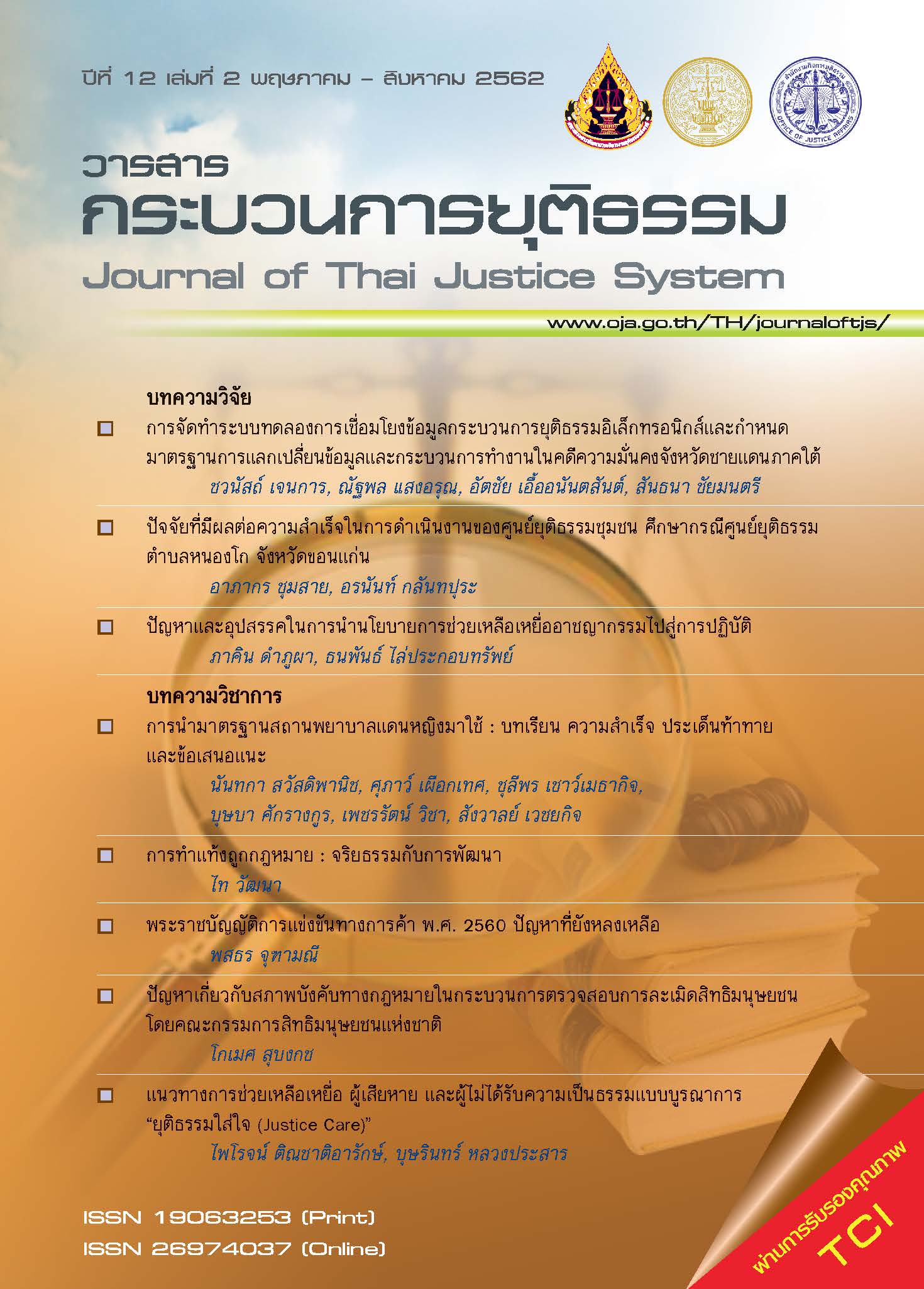The Remaining Problems after the Amendment of the Thai Competition Law 2017
Main Article Content
Abstract
Thailand has implemented the competition law since 1999 however, none of anti-monopoly measure has come into effect through the existence of this competition law. A new competition law has just been introduced in 2017 in order to improve problems and limitations of the old competition law. The amendment of the new competition law would better maintain market competition in many aspects. However, many remaining problems are still noticed and the new law might inadequately prevent abusive behavior of the huge firm in dominating market. First of all, the independency of competition authority still becomes a doubt while the politicians still held the power to select and appoint the competition committee. Secondly, one of the anti-monopoly measure is to ban an excessive market share of a company that tends to lead a dominant position of the company in the market. In the new law, the competition authority could impose a certain limit of market share in a vulnerable trading market or service. In fact, the competition authority has never collected and disclosed the market information to the public. The market information is required under the new law in order to detect the trend when an oligopoly or monopoly happens to which type of market or service and who is becoming the dominant. The recommendation from this article is to promote more independency of the competition authority and the ease of access and comprehensive market database is needed. Even under the new law, the case study of anti-monopoly practice has never been implemented. This limits an opportunity to learn the effect of competition law enforcement in Thailand. The experience and lessons from the other countries might be needed in the study of competition enforcement.
Article Details
Published Manuscripts are the copyright of the Journal of the Justice System. However; the opinions that appeared in the content are the sole responsibility of the author.
References
จันทร์ทอง เจริญหิรัญยิ่งยศ. (2543). สภาพตลาดในประเทศไทยกับกฎหมายการแข่งขันทางการค้า. (วิทยานิพนธ์ปริญญามหาบัณฑิต). มหาวิทยาลัยธรรมศาสตร์, กรุงเทพมหานคร.
ศักดา ธนิตกุล. (2553). คำอธิบายและกรณีศึกษาพระราชบัญญัติการแข่งขันทางการค้า พ.ศ. 2542. กรุงเทพมหานคร: วิญญูชน.
สรวิศ ลิมปรังษี. (2543). กฎหมายแข่งขันทางการค้า : แนวคิดพื้นฐาน เจตนารมณ์ และปัญหา. กรุงเทพมหานคร: นิติธรรม.
สุธีร์ ศุภนิตย์. (2555). หลักการและกฎเกณฑ์แห่งพระราชบัญญัติการแข่งขันทางการค้า พ.ศ. 2542. กรุงเทพมหานคร: สำนักพิมพ์มหาวิทยาลัยธรรมศาสตร์.
สุธีร์ ศุภนิตย์, กมลชัย รัตนสกาววงศ์, วัชรียา โตสงวน, และ วิไลวรรณ วรรณนิธิกุล. (2536). แนวทางการพัฒนากฎหมายแข่งขันทางการค้าในประเทศไทย. กรุงเทพมหานคร: สำนักงานคณะกรรมการกฤษฎีกา.
สถาบันวิจัยเพื่อการพัฒนาประเทศไทย. (2554). พระราชบัญญัติว่าด้วยการแข่งขันทางการค้า พ.ศ. 2542: ข้อจำกัดและการปฏิรูป. รายงานทีดีอาร์ไอฉบับพิเศษ, ฉบับที่ 92.
อานันท์ เกียรติสารพิภพ. (2558). การผูกขาดและการแข่งขันที่เป็นธรรม: การปฏิรูปกฎหมายการแข่งขันทางการค้า. ค้นจาก https://library2.parliament.go.th/ebook/e_hotissue.html
เดือนเด่น นิคมบริรักษ์. (2555). การปฏิรูปเพื่อลดการผูกขาดและส่งเสริมการแข่งขันในเศรษฐกิจไทย. กรุงเทพมหานคร: เป็นไท.
เดือนเด่น นิคมบริรักษ์, เสาวลักษณ์ ชีวสิทธิยานนท์ และ มาเรียม กรีมี. (2544). โครงการศึกษาการปฏิบัติทางการค้าที่ไม่เป็นธรรมของประเทศต่างๆ เพื่อการพัฒนาแนวปฏิบัติตามมาตรา 29ตามกฎหมายการแข่งขันทางการค้า ตามโครงการส่งเสริมระบบการแข่งขันทางการค้าที่เกื้อหนุนต่อการส่งออก. กรุงเทพมหานคร: สถาบันวิจัยเพื่อการพัฒนาประเทศไทย.
เดือนเด่น นิคมบริรักษ์ และ ประสพสุข สังข์บุญมาก. (2550). Trade and Competition รายงานการบรรยายทางวิชาการ. กรุงเทพฯ: โรงพิมพ์มหาวิทยาลัยธรรมศาสตร์.


